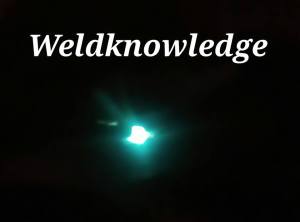Tungsten electrodes are used when arc welding with the GTAW process or when plasma welding. In both processes the electrode, arc and weld pool are protected from atmospheric contamination by an inert gas. A tungsten electrode is used because it can withstand very high temperatures with minimal melting or erosion. Electrodes are made by powder metallurgy and are formed to size after sintering.
TIG welding electrodes usually contain small quantities of other metallic oxides (dopants) which can offer the following benefits:-
- facilitate arc starting
- increase arc stability
- Improve current-carrying capacity of the rod.
- reduce the risk of weld contamination
- increase electrode life
Physical Characteristics of oxides:
Electron Work Function (eV)
The work function is the energy needed to remove an electron from an atom and is measured in electron volts (eV). The lower the work function of an electrode, the lower the voltage necessary to strike an arc, thus the easier the arc starts. The oxides added to tungsten serve to promote the electron emission by lowering the work function of the tungsten.
The oxide work function is important because the lower the eV for the oxide, the easier it will start. The metal work function is important, because upon emitting an oxide the metal is left as a film on the tip. The lower the eV of the metal at the tip, the lower the temperature will be at the tip which will decrease grain growth and provide a constant flow of oxides and longer service life.
For each type of oxide, the more of an oxide added to tungsten by the manufacturer, the lower the work function that tungsten will have and thus the better it will arc start.
Material Oxide eV Metal eV
Lanthanum 2.5 3.3
Thorium 2.6 3.35
Cerium 3.2 2.84
Pure Tungsten No oxide present 4.5
Migration and Evaporation Rates- The migration rate, or diffusion rate as it is often called, is the rate at which each of the different oxides naturally travels from inside the tungsten to the heat at the tip of the electrode. The evaporation rate is the rate at which the oxides separate from their metal component and are emitted at the tip of the electrode once they finish migrating there. The optimum-performing electrode is one, which has a balance of good migration and evaporation rates. If the migration rate is slower than the evaporation rate, then there will be an inadequate amount of oxides arriving at the tip to maintain a consistent arc and the tungsten may be reduced to the performance level of pure tungsten. This is due to an inadequate replenishment of oxides from inside the tungsten to the surface. If the evaporation rate is slower than the migration rate, the oxides will be crowded at the point. If both of the rates are very high, welding properties at the beginning of welding will be great, but all of the oxides may be used up quickly. As mentioned earlier, the migration of oxides to the surface not only depends on the physical properties of the oxide but also the manufacturing techniques used (i.e. oxide distribution, grain size, and structure).
Type of Tungsten electrodes and their features:
- Pure Tungsten: Non-radioactive; suitable for AC welding of aluminum, magnesium, and their alloy.
- Thoriated Tungsten: Excellent electron emission and overall performances; high current-carrying capacity; radioactivity; suitable for DC welding of carbon steel, stainless steel, nickel alloy and titanium alloy.
- Lanthanum Tungsten: Non-radioactive; excellent electric conductivity and welding capacity; high current-carrying capacity; minimum ratio of burnt area; substitute for thoriated tungsten electrode; mainly used in DC welding.
- Cerium Tungsten: Non-radioactive; easier arc initiation under low current circumstances, and low arc-maintaining current; suitable for the welding of pipelines, small components and discontinuous welding.
- Yttrium Tungsten: Non-radioactive; long and slim arc beam with high compression; deeper burning groove under medium and high current circumstances.
P.S. : Thoria was added as the first dopant and other oxides experimented after then.
Keep reading, Happy welding
Thank you,
KP Bhatt

Other than tungsten, which metal or alloy can be used???
LikeLike
According to Richardson-Dushman equation, the current density of thermionic emission depends critically on the cathode surface temperature. And thus only when cathodes of refractory materials such as tungsten or carbon, which have boiling point more than 4000 K when used then only specific current density can be achieved. And carbon electrode not recommended as during welding it lead to carbon pick in the weld pool.
LikeLike
Ohk…
Actually I have heard that, Mo can also be used… is it true? ?
LikeLike
yes, it can also be used but as its surface temperature is lower than tungsten it is not recommended. but yes on heating Mo shows thermionic emission.
LikeLike